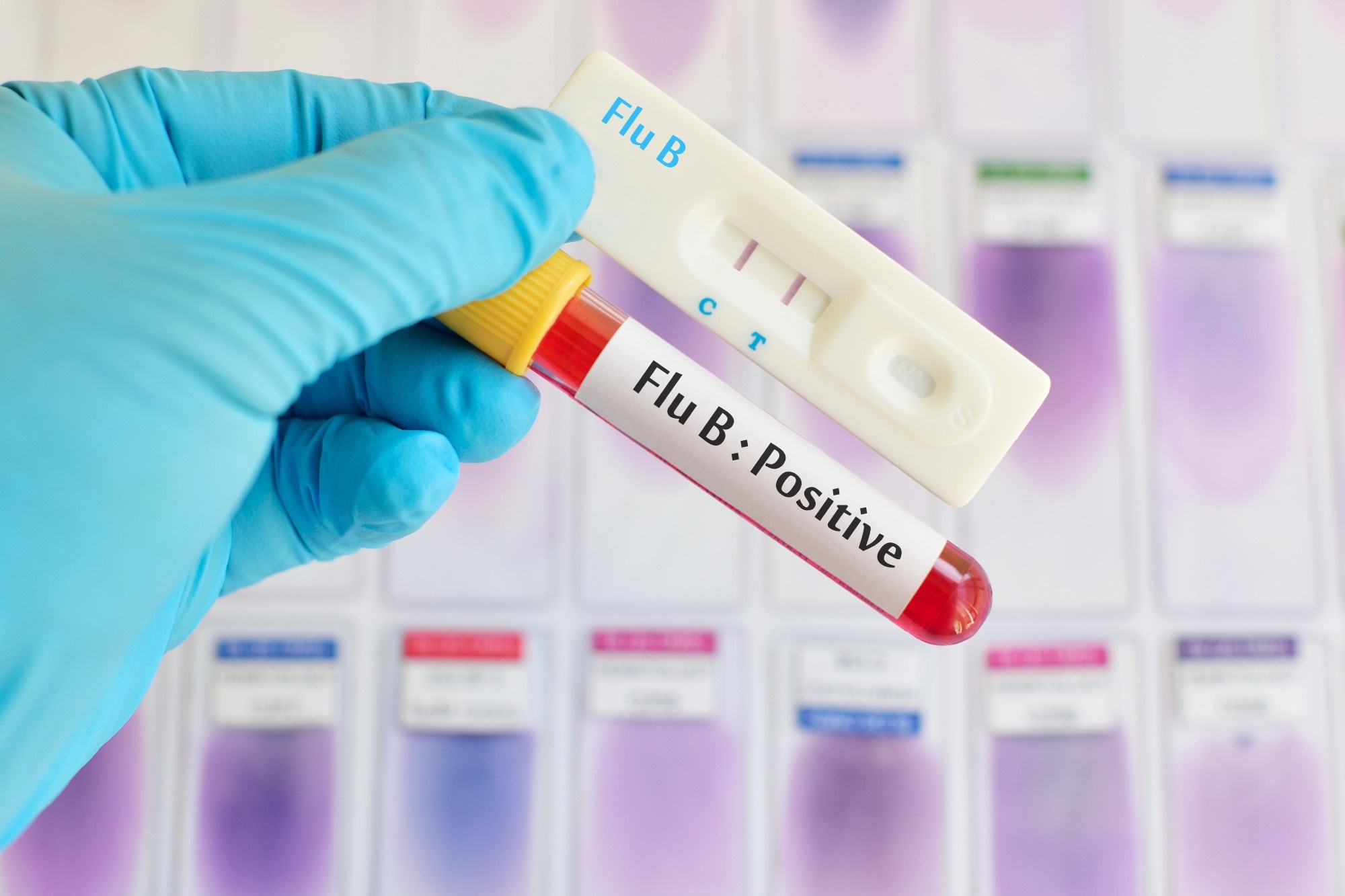In an article recently published in the journal Chemosensors, researchers proposed a sensitive and rapid influenza B virus (IBV) detection approach using silver (Ag)-doped ZnIn2S4 quantum dot (Ag: ZIS QD)-based nanocomposite spheres.
 Study: Influenza B Virus Detection with Quantum Dot-based Fluorescence Biosensors. Image Credit: Jarun Ontakrai/Shutterstock.com
Study: Influenza B Virus Detection with Quantum Dot-based Fluorescence Biosensors. Image Credit: Jarun Ontakrai/Shutterstock.com
Background
IBV is a major respiratory pathogen that induces respiratory infections, ranging from severe pneumonia to mild symptoms. Thus, accurate and rapid IBV detection is critical for influenza prevention, timely treatment, and early diagnosis. Lateral flow immunoassay (LFIA) technology serves a key role as a rapid and simple biosensor in influenza virus detection.
This cost-effective and sensitive method is one of the most extensively utilized point-of-care testing (POCT) sensors. LFIA can provide precise and rapid outcomes in IBV detection by targeting the protein antigen of the virus. This careful selection of markers is critical in improving sensitivity.
Importance of Quantum Dots
In the biomedical field, QDs have emerged as novel fluorescent labels with advantages like high fluorescence quantum yields, extended lifetimes, and narrow fluorescence emission peaks, which make them suitable as biomarkers. The integration of QDs with LFIA and using them as labeled antibodies can improve stability and sensitivity in detection and enable simultaneous detection of several markers, allowing multifactorial analysis.
Yet, QDs often face aggregation-induced luminescence quenching effects in real-world applications. To address this challenge, the construction of composite materials by combining QDs with other functional materials, such as polystyrene and silica nanoparticles, can significantly enhance fluorescence stability and biocompatibility.
By employing this approach, not only is the fluorescence quenching of QDs mitigated but the signal is also amplified, leading to a substantial improvement in detection specificity and sensitivity. Utilizing dendritic mesoporous silica nanoparticles (DMSNs) as carriers, which possess a vast specific surface area and expanded radial pore structures, enables the attachment of a greater number of QDs. This ensures stable luminescence and further amplifies the signal, enhancing overall detection performance.
The Proposed QD-based Approach
In this study, researchers developed a convenient and rapid screening method for IBV proteins using a fluorescence lateral flow biosensor based on Ag: ZIS QDs as signal reporters. These Ag: ZIS QDs emitting orange fluorescence were loaded onto DMSNs and were coated using a layer of silica shell to create a core-shell structured composite nanomaterial SiO2 @ Ag: ZIS QDs @ DMSNs as the signal reporting entity.
The study capitalized on the simplicity of a lateral flow detection platform to develop a one-step, straightforward fluorescent lateral flow biosensor for rapid screening of IBV proteins. The distinctive orange fluorescence emitted by this biosensor effectively eliminates interference from blue background fluorescence, leading to a significant enhancement in detection sensitivity.
Ag: ZIS QDs were synthesized using a hydrothermal process. Initially, 870.1 mg indium (III) acetate and 226.3 mg zinc acetate were dissolved in 70 mL deionized water to prepare a precursor solution, and then, 565.8 mg silver nitrate was added into the precursor solution to initiate the Ag: ZIS QD formation.
Subsequently, a L-cysteine-containing solution was introduced with robust stirring, which was followed by pH adjustment to 8.5 using a 1.0 M sodium hydroxide solution and the addition of an additional amount of thioacetamide. A polytetrafluoroethylene-lined hydrothermal autoclave was used to seal the as-obtained mixture.
The sealed mixture was heated to 110 °C for four hours and then cooled to room temperature. After cooling, the Ag: ZIS QDs were separated through centrifugation for 30 minutes at 10,000 rpm and washed three times using a solution containing ethanol and water by centrifugation. Eventually, the obtained purified QDs were dispersed in deionized water.
The Ag: ZIS QDs water solution was later used for SiO2 @ Ag:ZIS QDs @ DMSNs preparation. A Huawei smartphone was employed to capture fluorescent images under a 365 nm UV lamp, and the ImageJ software was used to analyze the fluorescence intensity.
Significance of the Study
The results showcased the exceptional loading capacity of DMSNs and the robust attachment of Ag: ZIS QDs to DMSNs, indicating the successful preparation of the Ag: ZIS QDs @ DMSNs nanocomposite materials. Additionally, successful SiO2 encapsulation on the surface of Ag: ZIS QDs @ DMSNs was demonstrated. This encapsulation prevented the detachment of Ag: ZIS QDs and reduced the fluorescence intensity of the composite material. However, it also improved the material's stability in both alkaline and acidic environments.
The presence of silicon, oxygen, silver, zinc, indium, and sulfur was detected in Ag: ZIS QDs @ DMSNs, which confirmed the QDs' successful loading. Additionally, the SiO2 @ Ag: ZIS QDs @ DMSNs' fluorescence intensity remained stable over time, meeting the requirements for LFIA.
Most importantly, the technology displayed exceptional performance in the immediate detection of IBV, with a 1 ng/mL minimum detection limit compared to a 6 ng/mL detection limit in conventional colloidal gold strip. Moreover, both intra-assay and inter-assay coefficients of variation were less than 9%.
To summarize, the findings of this study demonstrated the feasibility of using the proposed approach extensively in epidemiological investigation, epidemic surveillance, and early diagnosis of IBV.
Journal Reference
Hu, J., Zhu, L., Wu, S., Ding, S. (2024). Rapid and Sensitive Detection of Influenza B Virus Employing Nanocomposite Spheres Based on Ag-Doped ZnIn2S4 Quantum Dots. Chemosensors, 12(4), 68. https://doi.org/10.3390/chemosensors12040068, https://www.mdpi.com/2227-9040/12/4/68
Disclaimer: The views expressed here are those of the author expressed in their private capacity and do not necessarily represent the views of AZoM.com Limited T/A AZoNetwork the owner and operator of this website. This disclaimer forms part of the Terms and conditions of use of this website.
Article Revisions
- Apr 26 2024 - Title changed from "Influenza B Virus Detection with QD-based Fluorescence Biosensors" to "Quantum Dot Biosensors for Rapid Influenza Testing "